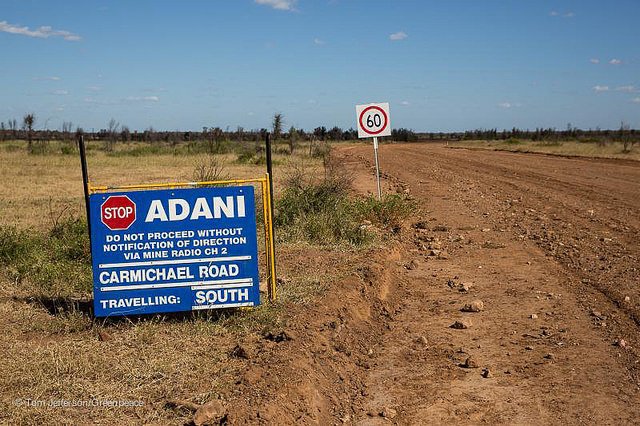
Proceedings in the Queensland Land and Environment Court concerning the objection by conservation group Land Services of Coast and Country (LSCC) to the Adani Carmichael coal mine in the Galilee Basin are drawing to a close.
LSCC’s objection to the mine is based on the claim that it poses an unacceptable danger to climate change, groundwater, the Great Barrier Reef and the endangered black-throated finch.
In his opening submission, barrister Saul Holt SC, representing LSCC, said Australia’s economic benefit does not outweigh the environmental costs. He said the future economic viability of thermal coal was uncertain and Adani’s estimated profits were “massively overstated”, considering the price of thermal coal has dropped “60 per cent recently”.
Before the hearings, the court visited the mine site. This allowed the court to see first-hand the groundwater springs, threatened species and scale and nature of the proposed mine site.
Several witnesses gave evidence of the impact the Carmichael mine would have on the Great Barrier Reef. Derec Davies of LSCC said the mine, which will be the third largest coalmine in the world, poses unacceptable risks to our climate and to our national treasure the Great Barrier Reef.
“Our case is that greenhouse gases emitted from the burning of coal from this mine will exacerbate climate impacts on the Great Barrier Reef, including coral bleaching events, significant loss of biodiversity, and ocean acidification resulting in the loss of precious corals,” he said.
“The Reef creates 64,000 jobs and provides $5-6 billion to the state’s economy, every year. The protection of the Reef should be Queensland’s number one priority.”
Evidence was given by marine scientist Professor Ove Hoegh Guldberg on how greenhouse gases produced from the burning of Carmichael coal and resulting climate change will impact the Great Barrier Reef.
To keep global warming under 2°C, global emissions will have to be kept to under 850 gigatonnes of carbon dioxide. The Carmichael mine alone would contribute 4.5 gigatonnes of emissions, Hoegh Guldberg told the court.
“We’re talking about 0.5% of the total emissions left … before we push the climate into a very dangerous state,” he said. “That’s an enormous amount of carbon dioxide over the life of the mine.”

The impact of the Carmichael mine on ground water, endangered flora and fauna was, on evidence presented, not apparently justified on economic grounds. Rajesh Gupta, Group Financial Controller at Adani Mining revealed for the first time that the mine will fail to generate the $22 billion royalties that Adani has consistently claimed. The true figure is about $7.8 billion.
In a further revelation, evidence was given that Adani has grossly inflated the number of jobs the mine will provide. Adani’s own expert witness, Dr Jerome Fahrer, admitted that the mine and railway will only produce 1464 jobs – far fewer than the 10,000 jobs Adani has trumpeted on its website. This number represents less than half the number of jobs lost in Queensland coalmines in the past three years.
The LSCC’s expert witness, Executive Director of The Australia Institute Dr Richard Denniss, expressed “surprise” at the Adani expert’s economic modelling, which showed that an increase in the supply of coal would not affect coal prices. Denniss said this “would fail first year economics”.
In evidence on the mine’s effect on climate change, Senior Associate Environmental Scientist with URS Corporation Dr Chris Taylor for Adani said that approval of the mine would have a minimal effect on domestic emissions. He said that emissions from burning Carmichael coal overseas was not the responsibility of Adani, but of the country that burnt the coal.
LSCC’s expert witness on climate impact, Associate Professor Malte Meinshausen, said he had no doubt of the climate impact of the proposed mine. When cross examined by counsel for Adani about the direct and indirect impact from mining and the subsequent burning of the coal he did not agree that domestic emissions from mining itself were negligible.
He was prepared to say they were small but all the small emissions from individual mines put together become significant. When Carmichael coal is consumed after export this will make a significant impact on climate change.
While proceedings are still underway, the hearing has highlighted weaknesses in the process of granting mining applications.
In a statement on April 28 Lock the Gate Alliance said: “The public has a lot to lose when huge new mines like Carmichael that will deplete groundwater and radically alter bush landscapes are approved by governments on the basis of information supplied by mining companies and not rigorously scrunitised.”
Like the article? Subscribe to Green Left now! You can also like us on Facebook and follow us on Twitter.